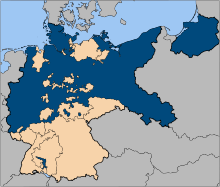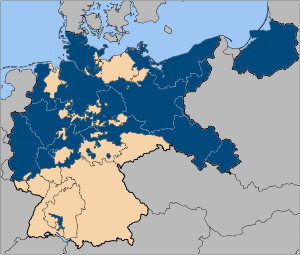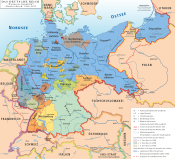Free State of Prussia
This article needs additional citations for verification. (October 2011) |
| Free State of Prussia Freistaat Preußen | |||||||||||
|---|---|---|---|---|---|---|---|---|---|---|---|
| Free state of the Weimar Republic | |||||||||||
| 1918–1933 | |||||||||||
 The Free State of Prussia (blue), within Germany at the time of the Weimar Republic | |||||||||||
| Capital | Berlin | ||||||||||
| Area | |||||||||||
• 1925 [1] | 292,695.36 km2 (113,010.31 sq mi) | ||||||||||
| Population | |||||||||||
• 1925 [1] | 38,175,986 | ||||||||||
| Government | |||||||||||
| • Type | Republic | ||||||||||
| Minister-President | |||||||||||
• 1918 | Friedrich Ebert | ||||||||||
• 1920–1933 | Otto Braun1 | ||||||||||
| Historical era | Interwar period | ||||||||||
• Established | 9 November | ||||||||||
• Nazi takeover, dismantlement of democratic institutions | 30 January 1933 | ||||||||||
| |||||||||||
| 1: Served three separate terms: 1920–1921, 1921–1925, 1925–1933. | |||||||||||
The Free State of Prussia (German: Freistaat Preußen) was a German state formed after the abolition of the Kingdom of Prussia in the aftermath of World War I. It was the major state of Germany during the time of the Weimar Republic, comprising almost 5/8 (62.5%) of its territory and population.[1] Free state is a German term for republic that was coined in contrast to the Latin word, which was associated with the enemy France in the minds of many Germans of that time.
The democratic Free State of Prussia was rendered incapacitated when it was taken over by a coup in 1932–1933 and Otto Braun was forced from office. His government went to court over this ouster and after the end of World War II Otto Braun approached U.S. officials to reinstate the legal Prussian government. They and the other Allied Occupation forces, who had occupied all of Germany, were opposed to the idea and declared Prussia abolished in 1947.
History of Prussia between 1918 and 1933
1918: Aftermath of World War I
Except for its overseas colonies and Alsace-Lorraine and the Bavarian parts of the Saargebiet, all German territorial losses as a result of World War I were Prussian losses. As specified in the Treaty of Versailles, the former kingdom lost territory to Belgium (Eupen and Malmedy), Denmark (North Schleswig), Lithuania (Memel Territory) and Czechoslovakia (the Hultschin area). The Saargebiet was administered by the League of Nations. The Rhine Province became a demilitarised zone.
The bulk of Prussia’s losses were to Poland, including most of the provinces of Posen and West Prussia, and an eastern section of Siliesia. Danzig was placed under the administration of the League of Nations as the Free City of Danzig. These losses separated East Prussia from the rest of the country, now only accessible by rail through the Polish corridor or by sea.
Since it contained so much of Germany's area and population, the government initially considered breaking Prussia up into smaller and more manageable states, but eventually traditionalist sentiment prevailed and Prussia continued unchanged, apart from its territorial losses.
1918–1932: Democratic bastion
The restrictive Prussian three-class franchise was abolished shortly after Kaiser William II abdicated. As a result, Prussia became a stronghold of the left. Its incorporation of "Red Berlin" and the industrialised Ruhr Area — both with working-class majorities — ensured left-wing dominance.
From 1919 to 1932, Prussia was governed by a coalition of the Social Democrats, Catholic Centre, and German Democrats; from 1921 to 1925, coalition governments included the German People's Party. Unlike in other states of the German Reich, majority rule by democratic parties in Prussia was never endangered. Nevertheless, in East Prussia and some industrial areas, the National Socialist German Workers Party (or Nazi Party) of Adolf Hitler gained more and more influence and popular support, especially from the lower middle class.
The East Prussian Otto Braun, who was Prussian minister-president almost continuously from 1920 to 1932, is considered one of the most capable Social Democrats in history. He implemented several trend-setting reforms together with his minister of the interior, Carl Severing, which were also models for the later Federal Republic of Germany (FRG). For instance, a Prussian minister-president could be forced out of office only if there was a "positive majority" for a potential successor. This concept, known as the constructive vote of no confidence, was carried over into the Basic Law of the FRG. Largely because of this provision, the centre-left coalition was able to stay in office because neither the far left nor the far right could possibly put together a majority.
In marked contrast to its prewar authoritarianism, Prussia was a pillar of democracy in the Weimar Republic. Most historians[who?] regard the Prussian government during this time as far more successful than that of Germany as a whole.
1932: Prussian coup
All of this changed on 20 July 1932 with the Preußenschlag ("Prussian coup"), where Reich Chancellor Franz von Papen unseated the democratic Free State of Prussia government under Otto Braun under the pretext that it had lost control of public order. This was triggered by a shootout between SA demonstrators and communists in Altona, Hamburg (Altona Bloody Sunday; Altona was still a part of Prussia at that time). After this emergency decree, Papen appointed himself Reich Commissioner for Prussia and took control of the government. This made it easy for Adolf Hitler to assume control over Prussia in the following year.
Otto Braun's government filed suit in the courts, but the cases remained unresolved due to the war and the subsequent Allied occupation and partition of Germany.
Government
Unlike its authoritarian pre-war predecessor, Prussia was a promising democracy within Germany. The abolition of the aristocracy transformed Prussia into a region strongly dominated by the left wing of the political spectrum, with "Red Berlin" and the industrial centre of the Ruhr Area exerting a major influence. During this period, a coalition of centre-left parties ruled, predominantly under the leadership of East Prussian Social Democrat Otto Braun. While in office he implemented several reforms together with his Minister of the Interior, Carl Severing, which were also models for the later Federal Republic of Germany. For instance, a Prussian prime minister could only be forced out of office if there was a "positive majority" for a potential successor[citation needed]. This concept, known as the constructive vote of no confidence, was carried over into the Basic Law of the Federal Republic of Germany. Most historians regard the Prussian government during this time as far more successful than that of Germany as a whole.
Similar to other German states both now and at the time, executive power was continued to be vested in a Minister-President of Prussia and laws established by a Landtag elected by the people.
Minister-Presidents of the Free State of Prussia
| # | Name | Took Office | Left Office | Party |
|---|---|---|---|---|
| 1 | Friedrich Ebert | 9 November 1918 | 11 November 1918 | SPD |
| 2 | Paul Hirsch | 11 November 1918 | 27 March 1920 | SPD |
| 3 | Otto Braun | 27 March 1920 | 21 April 1921 | SPD |
| 4 | Adam Stegerwald | 21 April 1921 | 5 November 1921 | Centre |
| - | Otto Braun (2nd term) | 5 November 1921 | 18 February 1925 | SPD |
| 5 | Wilhelm Marx | 18 February 1925 | 6 April 1925 | Centre |
| - | Otto Braun (3rd term) | 6 April 1925 | 20 July 1932 (ousted during the Preußenschlag) 30 January 1933 (formally deposed) |
SPD |
| Position suspended. Administered by the Reichskommissar |
20 July 1932 | 30 January 1933 | ||
| 6 | Franz von Papen | 30 January 1933 | 10 April 1933 | Independent |
| 7 | Hermann Göring | 10 April 1933 | 24 April 1945 | NSDAP |
Subdivisions of Prussia

Effects of World War I
- East: The Memel Region of East Prussia was ceded to Lithuania. The remainder of province of Silesia that was not ceded to Poland and Czechoslovakia was split into the provinces of Upper Silesia and Lower Silesia in 1919 — although they were temporarily recombined (1938-1941).
- North: In the province of Schleswig-Holstein, Allied powers organised two plebiscites in Northern and Central Schleswig on 10 February and 14 March 1920, respectively. In Northern Schleswig 75% voted for reunification with Denmark and 25% for staying with Germany, this new addition to Denmark formed the counties of Aabenraa, Haderslev, Sønderborg, and Tønder, from 1970 to 2007 this ceded areas were merged in South Jutland County. In Central Schleswig the situation was reversed with 80% voting for Germany and 20% for Denmark. No vote ever took place in the southern third of Schleswig.
- West: The southern tip of the Rhine Province was placed under French administration as the Saar by the League of Nations. The Eupen and Malmedy regions in the west of the Rhine Province were ceded to Belgium, forming the region that contains the German-speaking community of Belgium.
Changes prior to the Nazi Regime
In 1920, the Greater Berlin Act was passed to create Greater Berlin, enlarging the Prussian capital on the expense of Brandenburg, from which Berlin had been separated in 1881.[2] The Greater Berlin Act effectively enlarged the size of the city 13-fold, and its borders are largely maintained by the modern German state of Berlin.
The remainder of the provinces of Posen and West Prussia were combined to form Posen-West Prussia in 1922.
Changes after 1933 until 1947
For redeployments after 1933 see Free State of Prussia (1933-1947).
See also
References
- ^ a b Beckmanns Welt-Lexikon und Welt-Atlas. Leipzig / Vienna: Verlagsanstalt Otto Beckmann. 1931.
- ^ On 1 April 1881 Berlin was disentangled from the province of Brandenburg. Consisting of the mere one city of Berlin its lord mayor (German: Oberbürgermeister) fulfilled in personal union the task of the Landesdirektor and the city council the role of the provincial committee. While the role of the upper president was taken by the Prussian government-appointed chief of police (German: Polizeipräsident in Berlin). Cf. Meyers großes Konversations-Lexikon: 20 vols. – completely rev. and ext. ed., Leipzig and Vienna: Bibliographisches Institut, 1903-08, here vol. 2, article 'Berlin', p 700. No ISBN



